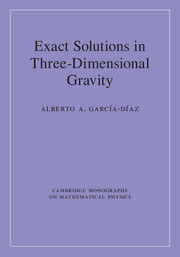Book contents
- Frontmatter
- Contents
- Preface
- 1 Introduction
- 2 Point Particle Solutions
- 3 Dust Solutions
- 4 A Shortcut to (2+1) Cyclic Symmetric Stationary Solutions
- 5 Perfect Fluid Static Stars; Cosmological Solutions
- 6 Static Perfect Fluid Stars with Λ
- 7 Hydrodynamic Equilibrium
- 8 Stationary Circularly Symmetric Perfect Fluids with Λ
- 9 Friedmann–Robertson–Walker Cosmologies
- 10 Dilaton–Inflaton Friedmann–Robertson–Walker Cosmologies
- 11 Einstein–Maxwell Solutions
- 12 Black Holes Coupled To Nonlinear Electrodynamics
- 13 Dilaton Field Minimally Coupled to (2 + 1) Gravity
- 14 Scalar Field Non-Minimally Coupled to (2+1) Gravity
- 15 Low-Energy (2+1) String Gravity
- 16 Topologically Massive Gravity
- 17 Bianchi-Type (BT) Spacetimes in TMG; Petrov Type D
- 18 Petrov Type N Wave Metrics
- 19 Kundt Spacetimes in TMG
- 20 Cotton Tensor in Riemannian Spacetimes
- References
- Index
20 - Cotton Tensor in Riemannian Spacetimes
Published online by Cambridge University Press: 30 August 2017
- Frontmatter
- Contents
- Preface
- 1 Introduction
- 2 Point Particle Solutions
- 3 Dust Solutions
- 4 A Shortcut to (2+1) Cyclic Symmetric Stationary Solutions
- 5 Perfect Fluid Static Stars; Cosmological Solutions
- 6 Static Perfect Fluid Stars with Λ
- 7 Hydrodynamic Equilibrium
- 8 Stationary Circularly Symmetric Perfect Fluids with Λ
- 9 Friedmann–Robertson–Walker Cosmologies
- 10 Dilaton–Inflaton Friedmann–Robertson–Walker Cosmologies
- 11 Einstein–Maxwell Solutions
- 12 Black Holes Coupled To Nonlinear Electrodynamics
- 13 Dilaton Field Minimally Coupled to (2 + 1) Gravity
- 14 Scalar Field Non-Minimally Coupled to (2+1) Gravity
- 15 Low-Energy (2+1) String Gravity
- 16 Topologically Massive Gravity
- 17 Bianchi-Type (BT) Spacetimes in TMG; Petrov Type D
- 18 Petrov Type N Wave Metrics
- 19 Kundt Spacetimes in TMG
- 20 Cotton Tensor in Riemannian Spacetimes
- References
- Index
Summary
In this chapter a systematic derivation of the Cotton tensor is presented following García et al. (2004). In 3D spaces the Cotton tensor is prominent as the substitute for the Weyl tensor. It is conformally invariant and its vanishing is equivalent to conformal flatness. However, the Cotton tensor arises in the context of the Bianchi identities and is present in any dimension n. In this text, its irreducible decomposition is performed and the number of independent components as n(n2−4)/3 is determined. Subsequently, its characteristic properties are exhibited. An algebraic classification of the Cotton tensor in three dimensions is accomplished. This classification is used throughout this text; for each class of the derived here solutions the Cotton tensor is evaluated and classified.
The nonlinear coupling of gravity to matter in general relativity presents difficult technical problems in attempts to understand the gravitational interaction of elementary particles and strings or to investigate details of the gravitational collapse; see Witten (1991). Progress in the former area has come mainly from treating quantum fields as propagating on fixed background geometries: Polchinski (1998), whereas much of the progress in the latter has come from detailed numerical works: Choptuik (1993); Abrahams and Evans (1993); Gundlach (1999).
Exact solutions of the relevant matter–gravity equations can play an important role by shedding light on questions of interest in both general relativity and string theory. One is often interested in certain classes of solutions with specified asymptotic properties; the most common of them are the asymptotically flat spacetimes. Recent work in string theory has, via the AdS/CFT conjecture, highlighted the importance of the asymptotically AdS spacetimes, see Maldacena (1998). The AdS/CFT correspondence relates a quantum field theory in d dimensions to a theory in d + 1 dimensions that includes gravity Gubser et al. (1998), and Witten (1998). This is the motivation for looking at the conformally flat spaces and at the spaces of constant curvature. For this reason we decided to review the subject and to collect some old and new results that are nowadays important in the context of anti-de Sitter spacetimes and to present them in modern language. These results seem presently not to be too well known in the community.
- Type
- Chapter
- Information
- Exact Solutions in Three-Dimensional Gravity , pp. 404 - 420Publisher: Cambridge University PressPrint publication year: 2017



